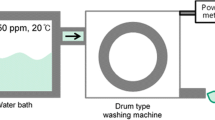Abstract
It is expected that energy consumption and usage of water for automatic laundry washing will increase globally in the next decades. Besides the technical development of washing machines, optimized consumer behavior is considered to be an effective measure in terms of saving resources for washing laundry. This work investigates the energy and water saving potential of load increase and temperature reduction in automatic laundry washing processes. The calculations are based on the A.I.S.E.—Laundry and Cleaning Habits study, providing reliable data on consumer behavior with laundry washing in 23 European countries. The results show that savings of up to 50 % in energy and water consumption are possible. In total, savings of more than 12 TWh of electricity and about 870 million m3 of water could be achieved every year by increasing the water and energy efficiency of washing machines and changing the consumer behavior towards better use of the washing machine capacity and the frequent use of low wash temperatures.

Similar content being viewed by others
References
A.I.S.E. (2011). Survey—laundry and cleaning habits study, Insites.
Baiocchi, G., Minx, J., & Hubacek, K. (2010). The impact of social factors and consumer behavior on carbon dioxide emissions in the United Kingdom. Journal of Industrial Ecology, 14, 50–72.
Barthel, C., & Götz, T. (2013). The overall worldwide saving potential from domestic washing machines. With results detailed for 10 world regions. Appliances Guide bigEE, Wuppertal, Germany. http://www.bigee.net/en/appliances/guide/residential/group/3/ (last access: 31.10.2013).
Berkholz, P., Brückner, A., Kruschwitz, A. & Stamminger, R. (2007). Verbraucherverhalten und verhaltensabhängige Einsparpotentiale beim Betrieb von Waschmaschinen. Aachen, 146.
Bertoldi, P. & Antanasiu, B. (2009). Electricity consumption and efficiency trends in the European Union. European Commission, Brussels. http://iet.jrc.ec.europa.eu/sites/default/files/documents/scientific_publications/2009/eneff_report_2009.pdf (last access: 29.10.2013).
Chapagain, A. K., Hoekstra, A. Y., Savenije, H. H. G., & Gautam, R. (2006). The water footprint of cotton consumption: an assessment of the impact of worldwide consumption of cotton products on the water resources in the cotton producing countries. Ecological Economics, 60(2006), 186–203.
Doll, P., Kaspar, F., & Lehner, B. (2003). A global hydrological model for deriving water availability indicators: model tuning and validation. Journal of Hydrology, 270, 105–134.
EC (2006). World Energy Technology Outlook 2050—WETO H2. European Commission. http://ec.europa.eu/research/energy/pdf/weto-h2_en.pdf (last access: 29.10.2013).
Faberi, S., Pressuto, M., Stamminger, R., Scialdoni, R., Mebane, W. & Esposito, R. (2007) Preparatory study for eco-design requirements of EuPs. LOT 14 Domestic washing machines & dishwashers. Final Report Task 3–5–1. 373.
Forum Waschen (2013). http://forum-waschen.de/tl_files/content/pdf-waschen-abwaschen-reinigen/ Faltblatt-Nachhaltiges-waschen-13.pdf (last access: 21.11.2013).
IEA (2012). World Energy Outlook 2012: International Energy Agency. http://www.iea.org/newsroomandevents/speeches/weo_launch.pdf (last access: 29.10.2013).
Kruschwitz, A. & Stamminger, R. (2013) Consumer laundry practices in Germany. International Journal for Consumer Studies. submitted.
Pakula, C., & Stamminger, R. (2009). Electricity and water consumption for laundry washing by washing machine worldwide. Energy Efficiency, 3, 365–382.
Pressuto, M., Stamminger, R., Scaldoni, R., Mebane, W. & Esposito, R. (2007). Preparatory study of eco-design requirements of EuPs; Lot 14: domestic washing machines and dishwashers; Task 1–2. ISIS.
Stamminger, R. (2005). Old washing machines wash less efficiently and consume more resources. Hauswirtschaft und Wissenschaft, 3, 124–131.
Stamminger, R. (2011). Modelling resource consumption for laundry and dish treatment in individual households for various consumer segments. Energy Efficiency, 4, 559–569.
Stamminger, R., & Goerdeler, G. (2007). Aktionstag nachhaltiges Waschen—was macht der Verbraucher? SÖFW Journal, 133, 10.
Van Holsteijn en Kemna B.V. (2013). Omnibus review study on cold appliances, washing machines, dishwashers, washer-driers, lightning, set-top boxes and pumps. Brussels/Delft, p.44.
Wagner, G. (2010). Waschmittel–Chemie, Umwelt, Nachhaltigkeit (p. 334). Weinheim: Wiley-VWH.
Acknowledgments
The authors thank the International Association for Soaps, Detergents and Maintenance Products (A.I.S.E.) for providing the data.
Author information
Authors and Affiliations
Corresponding author
Appendix
Appendix
Rights and permissions
About this article
Cite this article
Pakula, C., Stamminger, R. Energy and water savings potential in automatic laundry washing processes. Energy Efficiency 8, 205–222 (2015). https://doi.org/10.1007/s12053-014-9288-0
Received:
Accepted:
Published:
Issue Date:
DOI: https://doi.org/10.1007/s12053-014-9288-0




